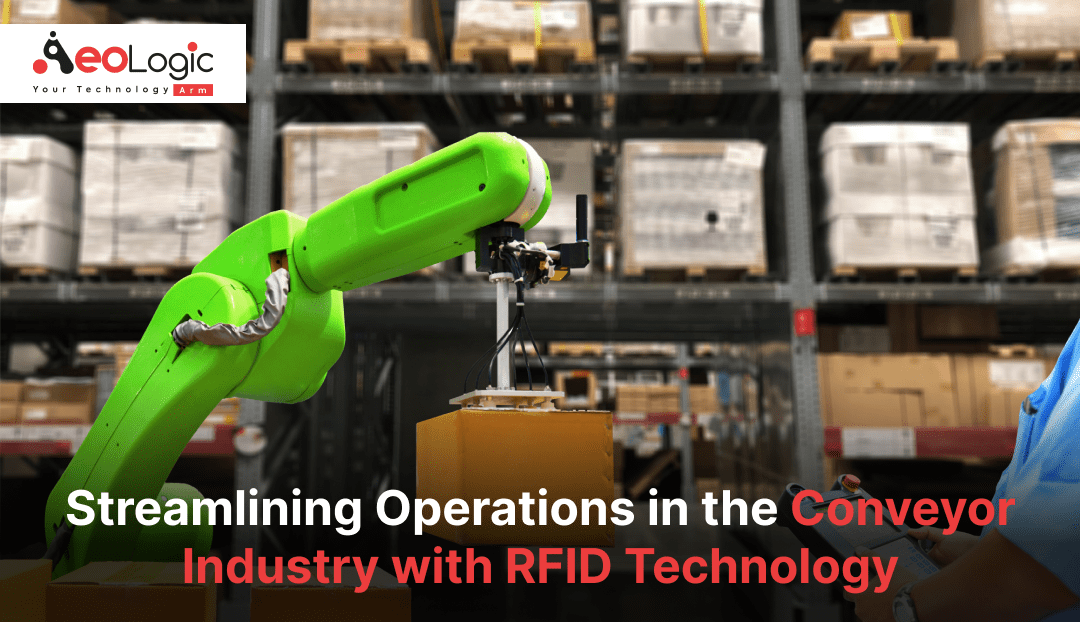In the manufacturing and logistics sectors, efficiency is not just a goal but a necessity. Conveyor systems are central to these industries, helping to transport goods and materials smoothly through various stages of production and distribution. However, even the most advanced conveyor systems can face challenges related to tracking, inventory management, and maintenance.
Radio Frequency Identification (RFID) technology offers a powerful solution to these challenges, streamlining operations and enhancing overall efficiency. In this blog, we’ll explore how conveyor industry with RFID technology can revolutionize conveyor systems, making them more efficient, accurate, and responsive to the demands of modern industries.
Also read: Boosting Rice Supply Chain Integrity through RFID Traceability Solutions
Understanding Conveyor Industry With RFID Technology
RFID technology uses radio waves to identify and track objects automatically. It consists of three main components: RFID tags, readers, and a backend system. The RFID tag contains a microchip with stored data and an antenna that transmits the information to an RFID reader. The reader captures the data and sends it to a central system for processing and analysis. This technology allows for the seamless tracking of items without direct line-of-sight, making it particularly valuable for conveyor industry with RFID technology.
Real-Time Tracking and Monitoring
One of the most significant benefits of RFID technology is its ability to provide real-time tracking of items as they move through conveyor systems. Each RFID tag on a product or container emits a unique identifier, which the reader captures as the item passes by. This continuous stream of data allows manufacturers and logistics providers to monitor the precise location, speed, and status of each item in real-time.
Real-time visibility is crucial for identifying and addressing bottlenecks or slowdowns in the conveyor industry with RFID technology. For example, if a conveyor belt is moving slower than usual or an item is stuck at a particular point, the RFID system can immediately alert operators. This prompt detection enables swift corrective actions, reducing downtime and minimizing disruptions to the production or distribution process.
Accurate Inventory Management
Accurate inventory management is essential for maintaining smooth operations and meeting customer demands. Traditional inventory counting methods can be prone to human error, leading to inaccuracies and discrepancies. Conveyor industry with RFID asset tracking automates the inventory counting process, significantly reducing the likelihood of errors.
By attaching RFID tags to products or containers, inventory can be tracked automatically as it moves through the conveyor system. The RFID system can synchronize with enterprise resource planning (ERP) systems, providing up-to-date information on stock levels, order statuses, and production schedules. This automation not only improves accuracy but also allows for real-time updates, ensuring that inventory data is always current and reliable.
Enhanced Quality Control
Quality control is a critical aspect of manufacturing and production. RFID technology can play a key role in enhancing quality control processes by providing detailed information about each item passing through the conveyor system. This information can include data on manufacturing processes, inspection results, and compliance with quality standards.
Integrating RFID data with quality control systems allows manufacturers to monitor and ensure that products meet specified standards throughout the production process. For instance, if a defect is detected in a batch of products, RFID data can help trace the issue back to its source, such as a malfunctioning machine or a specific batch of raw materials. This level of detail aids in addressing quality issues more effectively and preventing the distribution of defective products.
Streamlined Maintenance and Troubleshooting
Maintaining and troubleshooting conveyor systems can be challenging, particularly when dealing with complex machinery and components. RFID technology offers a solution by enabling predictive maintenance and providing detailed insights into the condition of conveyor components.
RFID tags can be placed on critical components such as belts, rollers, and motors to monitor their usage and wear. The data collected by the RFID system can be analyzed to predict when maintenance or replacement is needed, allowing for proactive scheduling of maintenance activities. This approach helps prevent unexpected breakdowns, reduces downtime, and extends the lifespan of conveyor equipment.
Additionally, RFID technology can assist in troubleshooting by providing historical data on component performance. If a conveyor system experiences a malfunction, the RFID system’s data can help diagnose the issue and identify potential causes, leading to faster and more effective repairs.
Improved Workflow and Efficiency
Workflow efficiency is a key factor in maximizing productivity and reducing operational costs. RFID technology can streamline workflow by automating processes that would otherwise require manual intervention. For example, RFID systems can facilitate automated sorting and routing of products on conveyor belts based on predefined criteria.
Automated sorting reduces the need for manual handling and minimizes the risk of errors, leading to faster processing times and improved overall throughput. Additionally, RFID systems can integrate with other technologies, such as robotic systems and automated guided vehicles (AGVs), to create a more cohesive and efficient production or logistics environment.
Data-Driven Decision Making
The data collected through RFID systems provides valuable insights into conveyor operations. Analyzing this data can help identify trends, measure performance metrics, and uncover areas for improvement. For instance, data on conveyor belt speeds, item processing times, and maintenance activities can be used to optimize system performance and make informed decisions.
By leveraging data-driven insights, manufacturers and logistics providers can implement continuous improvement strategies, such as adjusting conveyor speeds, reconfiguring workflows, or investing in new technologies. This data-driven approach enhances operational efficiency and supports long-term success.
The Future of RFID in Conveyor Systems
As technology continues to advance, RFID systems are expected to become even more sophisticated. Integration with other emerging technologies, such as the Internet of Things (IoT), artificial intelligence (AI), and machine learning, will further enhance the capabilities of RFID systems. These advancements will offer even greater opportunities for optimizing conveyor operations and driving innovation in the industry.
Also read: Top Benefits of RFID Integration With School ERPs System
Conclusion
In conclusion, RFID technology presents a significant opportunity for the conveyor industry to enhance efficiency, accuracy, and overall performance. By adopting RFID systems, manufacturers and logistics providers can achieve real-time visibility, automate inventory management, improve quality control, and make data-driven decisions that drive operational excellence. Embracing RFID technology will be a crucial step toward staying competitive and achieving long-term success in an increasingly demanding and fast-paced industry.







